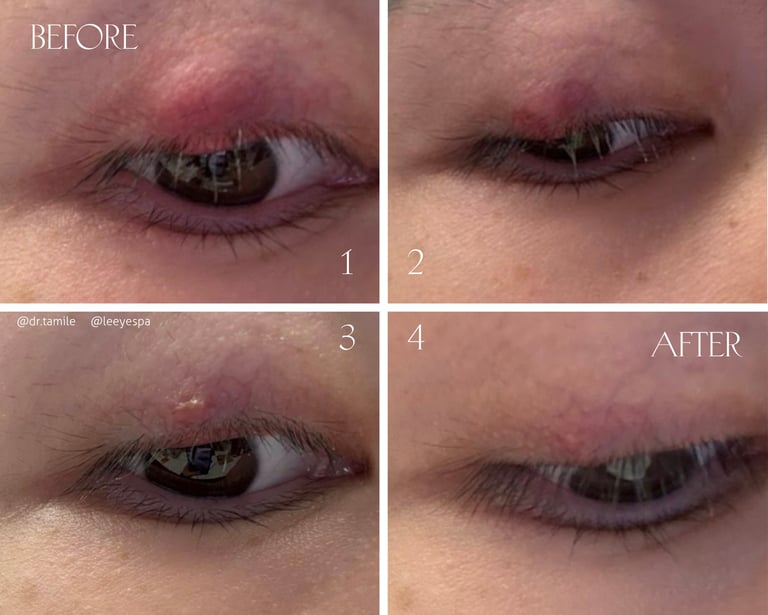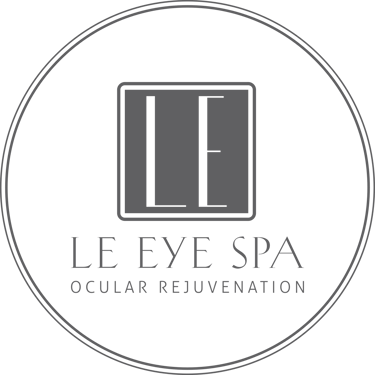What to Do If you Develop A Stye
A guide on what to do at home, when to see a doctor, and treatment options for "styes"
12/2/20244 min read
Stye | Chalazion | Hordeolum: A Complete Guide
If you've noticed a tender bump on your eyelid, you might have developed a stye. While not usually serious, styes can be uncomfortable and bothersome. So, what exactly is a stye, and how can you treat it? Here’s a breakdown of everything you need to know.
What is a Stye?
A stye, also known as a chalazion or hordeolum, is a small, swollen bump that forms on your eyelid. It typically starts as a tender, soft bump that may become red or painful. Styes develop when the oil glands in the eyelids become blocked, leading to inflammation and infection. This blockage can cause the oil to accumulate, forming a lump. Styes usually appear on the outer edge of the eyelid but can occasionally form on the inner surface.
How to Tell if You Have a Stye
A stye is easy to spot because it has a few distinguishing characteristics:
Tenderness or Pain: A stye may feel sore to the touch, especially when you blink or rub your eyes.
Redness and Swelling: The affected area of the eyelid will appear red and swollen, sometimes with a visible bump.
Pus or Pimple-like Appearance: As the stye develops, you may notice a small, pus-filled area in the center of the bump.
Irritation: You may experience irritation or a gritty feeling in your eye, similar to having something stuck in your eye.
How to Treat a Stye at Home
If you develop a stye, there are several steps you can take to help speed up the healing process and reduce discomfort.
Clean the Area: Always start by ensuring the affected area is clean and free from makeup or dirt. Avoid rubbing your eyes, as this can worsen the condition. If you have eyelash extensions, thoroughly clean the lashes with eyelid/lash wash AM and PM, remove all makeup at bedtime, and spray with ocular-approved hypochlorous acid for antibacterial purposes.
Use an Eyelid Cleanser: Over-the-counter eyelid cleansers or wipes are available, which can help remove any debris or excess oils from the area. This can prevent further irritation and support healing.
Apply Warm Compresses: One of the most effective treatments for a stye is a warm compress. Use a clean, soft cloth soaked in warm (not hot) water, and place it gently over your closed eyelid. Keep it there for at least 10 minutes, doing this at least twice a day. The warmth helps to loosen the blocked oil, encouraging the stye to drain naturally.
Gentle Massage: After applying the warm compress, you can gently massage the affected area in small, circular motions. This can help to break down the hardened oil and allow it to drain more effectively. Be sure to do this gently to avoid causing additional irritation.
Avoid Squeezing or Popping the Stye: It may be tempting to squeeze the bump, but this can push bacteria further into the skin and worsen the condition. Allow the stye to heal on its own, and let it drain naturally.
When to Call Your Eye Doctor
In most cases, a stye will resolve on its own with home treatment. However, there are times when it’s necessary to see an eye doctor. You should call your doctor if:
The stye doesn’t improve after a few days.
The area becomes increasingly red or swollen, or you notice that the redness is spreading.
You experience severe pain, vision changes, or if the stye interferes with your ability to see.
Professional Treatments for Styes
If home treatments aren’t effective, or if your stye becomes more serious, your eye doctor may recommend one of the following options:
Topical or Oral Medication: Your doctor may prescribe an antibiotic ointment or oral medication if the stye is infected. This can help eliminate bacteria and speed up the healing process.
Steroid Injection: In some cases, a steroid injection may be recommended to reduce inflammation and help the stye heal more quickly.
Excision: If the stye persists or becomes a chalazion (a type of stye that doesn’t resolve), your doctor may suggest a minor surgical procedure to remove it.
In-Office Treatments: Certain in-office treatments like radiofrequency (RF) therapy, intense pulsed light (IPL), or low level light therapy (LLLT) treatments may also be used to treat chronic styes or chalazia. These techniques gently target the oil glands with heat or light to improve drainage and reduce swelling. Many patients opt for this option as it does not involve incisions or needles. There is no downtime to these treatments.
Preventing Future Styes
While styes are not always preventable, there are a few steps you can take to reduce your risk:
Keep your eyelids clean: Regularly wash your face and eyelids with mild soap or a dedicated eyelid cleanser.
Avoid touching your eyes: Wash your hands frequently and try not to rub your eyes, which can transfer bacteria.
Remove makeup before bed: Always remove makeup before going to sleep to prevent blocked glands.
Replace old makeup: Old eye makeup can harbor bacteria, so be sure to replace makeup, such as mascara or eyeliner, every 3-6 months.
Conclusion
While styes can be annoying and uncomfortable, most cases can be managed with simple home treatments. Keep the area clean, apply warm compresses, and be patient as your body works to heal the infection. If symptoms worsen or don't improve after a few days, don’t hesitate to consult with an eye care professional to ensure the best treatment. With proper care, a stye will usually clear up without causing any long-term issues.


Chalazion treatment with IPL
Follow us
Subscribe to our newsletter
Hours
Appointment Only | Monday - Friday
Contact
9260 West Sunset Rd Ste 209, Las Vegas, NV 89148
Text or call: (702) 518-2711* | Fax: 888-830-5518
Email: info@leeyespa.com
*For fastest response times, please text or email


